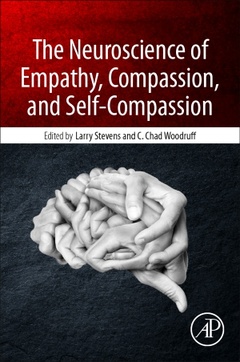Description
The Neuroscience of Empathy, Compassion, and Self-Compassion
Coordinators: Stevens Larry Charles, Woodruff C. Chad
Language: English
Subject for The Neuroscience of Empathy, Compassion, and Self-Compassion:
Keywords
<; P>; Empathy; Compassion; Self-Compassion; Neuroscience; Mirror Neurons; EEG; Electroencephalography; Neuroimaging; Cruelty; Meditation; Oxytocin<; /P>
353 p. · 15x22.8 cm · Paperback
Description
/li>Contents
/li>Readership
/li>Biography
/li>Comment
/li>
The Neuroscience of Empathy, Compassion, and Self-Compassion provides contemporary perspectives on the three related domains of empathy, compassion and self-compassion (ECS). It informs current research, stimulates further research endeavors, and encourages continued and creative philosophical and scientific inquiry into the critical societal constructs of ECS. Examining the growing number of electrocortical (EEG Power Spectral, Coherence, Evoked Potential, etc.) studies and the sizeable body of exciting neuroendocrine research (e.g., oxytocin, dopamine, etc.) that have accumulated over decades, this reference is a unique and comprehensive approach to empathy, compassion and self-compassion.
1. What Is This Feeling That I Have for Myself and for Others? Contemporary Perspectives on Empathy, Compassion, and Self-Compassion, and Their Absence 2. The Brain That Makes Us Concerned for Others: Toward a Neuroscience of Empathy 3. The Brain that Longs to Help Others: The Current Neuroscience of Compassion 4. The Brain That Longs to Help Itself: The Current Neuroscience of Self-Compassion 5. Sometimes I Get So Mad I Could …: The Neuroscience of Cruelty 6. Reflections of Others and of Self: The Mirror Neuron System’s Relationship to Empathy 7. Why does it feel so good to care for others, but only sometimes for myself? 8. Can We Change Our Mind About Caring for Others? The Neuroscience of Systematic Compassion Training 9. Compassion Training from an Early Buddhist Perspective: The Neurological Concomitants of the Brahmaviharas 10. The Language and Structure of Social Cognition: An Integrative Process of Becoming the Other 11. Where Caring for Self and Others’ Lives in the Brain, and How it can be Enhanced, and Diminished: Observations on the Neuroscience on Empathy, Compassion, and Self-Compassion
Upper-level undergraduate and graduate students and researchers in psychology, cognitive science, and neuroscience.
Dr. Woodruff is a Social Neuroscientist whose research aims to elucidate the brain mechanisms underlying empathy, sympathy and compassion as well as religious belief. He uses electroencephalography (EEG) to measure various brain signals, investigating how these signals relate to social neuroscience topics. Much of his research focuses on an EEG signal believed to reflect the activity of mirror neurons. These are neurons that not only code the intentions of an individual, but also seem to reflect the intentions of those with whom the individual interacts. Among the most important findings in his laboratory is that putative mirror neuron activity has a complicated relationship with empathy in which the one’s empathic abilities increase with the ability of his/her mirror neuron systems ability to distinguish self from other (self-other discrimination). Dr. Woodruff maintains a vibrant lab, typically employing 10-15
- Provides perspectives on empathy, compassion and self-compassion (ECS), including discussions of cruelty, torture, killings, homicides, suicides, terrorism and other examples of empathy/compassion erosion
- Addresses autonomic nervous system (vagal) reflections of ECS
- Discusses recent findings and understanding of ECS from mirror neuron research
- Covers neuroendocrine manifestations of ECS and self-compassion and the neuroendocrine enhancement
- Examines the neuroscience research on the enhancement of ECS
- Includes directed-meditations (mindfulness, mantra, Metta, etc.) and their effects on ECS and the brain




